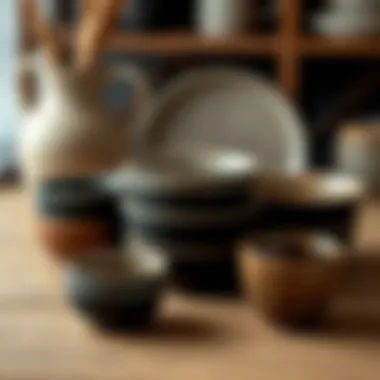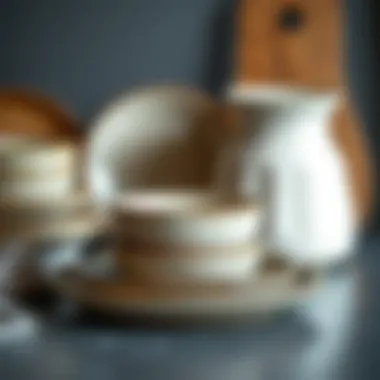Stoneware Dishes: The Blend of Durability and Style


Intro
When it comes to dining and entertaining, the choice of dinnerware speaks volumes about your taste and personality. Among the vast array of options available, stoneware dishes sit in a unique position, harmonizing functionality and style. Known for their durability and aesthetic appeal, stoneware has carved out a niche in homes across the globe. They aren't just pots and plates; they are artifacts that encompass culture, tradition, and craftsmanship. This exploration will take you through the nuanced world of stoneware dishes, from their historical roots to contemporary applications, emphasizing practical tips for selecting the right pieces to elevate any dining experience.
Furniture Design Trends
Trending Materials and Textures
Speaking of materials, stoneware falls into a category that resonates well with today’s design trends. Its tactile feel and glossy finish can give even a bland table setting a renewed touch. Unlike fragile porcelain or lightweight melamine, stoneware dishes boast a heftiness that makes them feel substantial and luxurious in hand. The natural clay used in its formation can be finished in various ways, from rustic textures to refined glaze options, allowing for a variety of styles that cater to specific themes in interior design.
Popular textures include:
- Matte: Offers a minimalist touch that’s easy on the eyes.
- Glossy: Brightens up a table and contributes to a warmer atmosphere.
- Textured: Adds depth and interest, perfect for casual dining setups.
Color Palettes and Styles
Color is crucial when it comes to merging stoneware with existing furniture and décor. There's no shortage of hues in stoneware dishes, ranging from earthy tones of terracotta and beige to vibrant bursts of blue and green.
This variety is essential as it allows homeowners and designers to curate a table that resonates with their overall aesthetic vision.
Current color trends include:
- Earthy Neutrals: Emphasize a natural feel, synergizing well with wooden or natural fiber furniture.
- Bold Accents: Bright colors can serve as eye-catching centerpiece items. They work especially well with neutral backdrops.
- Monochromatic Shades: Different shades of the same color can create an elegant and cohesive look.
Practical Tips for Stoneware Selection
Assessing Space and Functionality
When diving into stoneware selection, consider the practicality of the pieces. The dimensions of your dining space can heavily influence your choices. Larger, heavier dishes may be better suited for a grand dining table, while lighter options could better fit a quaint kitchen nook.
Think about the types of meals you typically host. If it’s family-style dining, opting for larger serving platters can enhance the communal atmosphere. Keep an eye out for nesting sets that offer versatility without overwhelming storage spaces.
Balancing Aesthetics with Comfort
Don't let the beauty of stoneware overshadow the fundamentals of comfort and usability. Look for designs that feel good to hold and serve with. Some stoneware pieces have ergonomic qualities, enhancing the user experience. When selecting dishes, aim for ones that you won’t just want to display but also enjoy using repeatedly. It's about creating an experience that feels cohesive and delightful, both visually and physically.
Stoneware not only emphasizes aesthetic value but serves as a bridge connecting functionality to artistry, facilitating memorable dining experiences.
In summary, understanding the practical aspects of stoneware dishes, alongside their aesthetic appeal, is crucial. Their unique characteristics give you the tools to create not just meals, but moments.
For further reading on stoneware's historical significance and its evolution in dining trends, visit Britannica or check out related discussions on Reddit.
Embrace stoneware dishes, and let each piece tell a story at your dining table!
Understanding Stoneware Dishes
Stoneware dishes represent a fascinating intersection of function and form, playing a pivotal role in both everyday cooking and dining. Their attributes make them more than just vessels for food; they are durable pieces that embody cooking traditions while offering contemporary style. Understanding stoneware entails appreciating its distinct composition, unique manufacturing methods, and the various types available. This foundational knowledge is essential for homeowners, designers, and anyone interested in enhancing their dining experience.
Definition and Composition
Stoneware is a type of ceramic that is fired at high temperatures, typically above 1,200 degrees Celsius. The result is a dense, non-porous material that is robust and resistant to chipping and cracking. Unlike earthenware, which is softer and more susceptible to damage, stoneware contains specific clays that make it highly durable.
Its composition often includes feldspar, which acts as a flux to lower the melting point during the firing process. This fusion creates a smooth and impermeable surface that can hold food liquids without staining. The blend of materials contributes to the signature earthy tones and textures that add aesthetic appeal, making stoneware an attractive choice for both serving and baking.
Manufacturing Process
Crafting stoneware is an intricate process that balances artistry with technical precision. Initially, raw materials like clay and minerals are mixed to create a homogeneous paste. This mixture is then molded into shape, either by hand or using machinery, depending on the desired design.
Once shaped, the stoneware is dried to remove excess moisture before being fired in a kiln. This firing process is critical; not only does it harden the clay, but it also influences the final texture and color. After the initial firing, a glaze may be applied to enhance the visual appeal and provide a protective layer. Finally, the stoneware is fired again at even higher temperatures, solidifying its strength.
"The manufacturing of stoneware is both an art and science, resulting in dishes that can withstand the rigors of everyday use while being pleasing to the eye."
Types of Stoneware
Stoneware comes in various forms, each with unique characteristics suited to different culinary tasks. Here’s a closer look at some common types:
- Baking Dishes: Designed for the oven, these dishes are typically thicker to ensure even heat distribution.
- Serving Plates: Ideal for presenting food, they often come in beautiful designs that enhance table settings.
- Casserole Dishes: These pieces are designed to handle a range of temperatures, making them versatile for cooking and serving.
- Mugs and Bowls: Everyday items that benefit from stoneware’s durability, bringing both practicality and style to the table.


Overall, understanding stoneware dishes aids in making informed choices for culinary and decor purposes. Their blend of durability and visual appeal ensures they remain a popular choice in homes and professional kitchens.
The Advantages of Stoneware
Stoneware dishes present a unique confluence of strength and elegance, establishing them as a popular choice among culinary enthusiasts and home designers alike. In the world of dining essentials, their advantages span functionality, aesthetics, and an authentic connection to culinary traditions. This section delves deeper into these benefits, illuminating the characteristics that make stoneware a worthy investment in both practicality and style.
Durability and Longevity
One of the standout features of stoneware is its durability. Made from a dense clay that undergoes high-temperature firing, stoneware can withstand the rigors of everyday use without easily chipping or cracking. This resilience means users can enjoy their favorite dishes without the thought of replacing them anytime soon.
- Impact Resistance: The thickness of stoneware gives it a robust quality, making it less prone to breakage compared to porcelain.
- Scratch Resistance: Its surface is generally harder than many other materials, which aids in keeping it pristine through regular use and cleaning.
"Investing in high-quality stoneware is like putting money in a bank—it pays dividends back into your daily life in terms of performance and appearance."
Heat Retention Properties
Heating stoneware dishes allows them to excel in heat retention, a feature that can elevate the dining experience. Once heated, they will keep food warm for longer periods, minimizing the need for constant reheating. This quality is particularly beneficial for serving stews, casseroles, or baked goods.
- Even Heat Distribution: Stoneware’s material allows for even heat distribution which enhances cooking efficiency.
- Perfect for Baking: The cooking capabilities of stoneware extend to baking as well. Certain brands manufacture specialized stoneware for bread making, producing a revered crust due to the way stone conducts heat.
Versatility in Cooking and Serving
Another advantage of stoneware lies in its versatility. It is suitable for a multitude of cooking methods—baking, roasting, broiling, and even microwave use in some cases. This adaptability makes it a staple in many kitchens, capable of transitioning seamlessly from oven to table.
- Multi-Functional: Users can prepare a dish and present it directly on the dining table without having to transfer the food to another dish, which reduces the cleanup burden.
- Design Variations: Stoneware comes in a variety of styles, colors, and finishes, allowing it to fit into nearly any home décor theme, from rustic to modern.
Aesthetic Appeal
When it comes to stoneware dishes, aesthetic appeal plays a substantial role in attracting those looking to enhance their dining experiences. Beyond mere function, the visual elements of stoneware can elevate mealtime from a simple necessity to an inspiring culinary showcase. It is not just the dishes themselves but how they seamlessly fit into and complement your living spaces that matters.
Design Trends in Stoneware
In today's market, design trends have pivoted towards a more minimalistic approach, focusing on simplicity while still maintaining elegance. Natural textures that convey warmth and comfort are becoming popular. Stoneware with hand-crafted looks draws attention; the irregularities and unique glazes tell stories of their own.
Moreover, there is a rising trend towards eco-friendly production processes. Dishes that showcase organic shapes or earthy tones not only appeal aesthetically but also reflect a conscientious choice by consumers. Popular brands emphasize these qualities, often highlighting the artisanal nature of their goods. The shift signifies a growing appreciation for sustainability alongside beauty.
Color Palettes and Patterns
Color can dramatically influence the overall aesthetic of stoneware dishes. Soft pastels and muted earth tones are often favored, aligning with contemporary decor trends aimed at creating a calming environment. Vibrant jewel tones can add a pop of color that transforms a dull table setting into a vibrant feast for the eyes.
Patterns, too, are evolving. Traditional motifs are making way for bolder graphics and abstract designs. Some designers experiment with splatter techniques, resulting in unique, one-of-a-kind pieces. These patterns aren't just visually appealing; they also serve to mask minor imperfections, making stoneware an appealing choice for everyday use.
The interplay of color and pattern can cater to diverse tastes, accommodating both modern and more traditional aesthetics. This adaptability makes stoneware an alluring addition to any kitchen.
Integration into Home Decor
Stoneware dishes go beyond their culinary uses; they can also serve as integral decorative components of home decor. Displaying these dishes in open shelving or on kitchen counters can create an inviting atmosphere. Their presence adds texture and warmth to otherwise sterile spaces, bridging the gap between functionality and style.
To effectively integrate stoneware into your home, consider the following:
- Color Coordination: Choose stoneware that resonates with the color scheme of your kitchen or dining area.
- Thematic Harmonization: If your decor leans toward rustic charm or modern minimalism, select stoneware that echoes those themes.
- Layering Techniques: Combine various sizes and styles in a single display to create visual interest without overwhelming a space.
Ultimately, the ability to blend beauty with practicality is what makes stoneware an essential choice for homeowners and designers alike. As you enhance your living space, remember that these dishes can be both art and utility, adding character to your home.
"A well-set table can change the entire atmosphere of a dining experience, making stoneware dishes essential not just for their function, but for their beauty."
In summary, the aesthetic appeal of stoneware dishes lies not only in their design and patterns but also in how they harmonize with our living environments. This captivating quality further solidifies stoneware as a choice that speaks to both practical needs and artistic desires.
Culinary Contexts
In the realm of culinary arts, stoneware dishes hold a significant role, blending utility with aesthetics seamlessly. As we dive into this section, we evaluate how stoneware enhances not just the cooking processes but also the experience of serving and enjoying food. Understanding these contexts gives insight into their multifaceted advantages, making stoneware an invaluable addition to both home kitchens and professional settings.
Use in Baking
Baking is often seen as an art, and stoneware dishes contribute a unique aspect to this craft. Their robust and even heat distribution fosters excellent cooking results, leaving the delicate balance between chewiness and crispiness well achieved. When you place a loaf of bread or a pie in a stoneware dish, you can almost feel that the dish itself is participating in the ritual.
- Heat Retention: Stoneware retains heat exceptionally well, allowing baked goods to stay warm longer once taken out of the oven.
- Non-stick Surface: Many stoneware options feature a naturally non-stick surface, enabling easier release of baked items—perfect for those intricate pastries.
- Versatile Usage: From bread to casseroles, stoneware is adaptable, serving different recipes with flair.
Because of its cooking benefits, stoneware enhances the texture and flavor of baked goods—whether it's a simple loaf or an elaborate dessert.


Serving Techniques
Presenting food in a visually pleasing manner can elevate an ordinary meal into a delightful experience. Stoneware dishes, with their rich variety of colors and textures, bring an elegance to any serving technique. When using stoneware, consider the following:
- Layering Presentation: Utilize shallow stoneware bowls or platters to layer foods, creating a colorful display that catches the eye, such as a buffet setup with a mix of salads and entrees.
- Rustic Table Settings: For casual gatherings, earthy stoneware pieces seamlessly blend with natural table settings. This informal aesthetic adds warmth to social occasions.
- Accessibility: Stoneware's durability means it can move from oven to table without a fuss, allowing hosts to serve dishes right in the baking vessel.
This ease in handling adds a layer of comfort for both cooks and guests, reinforcing that dining is about connection and enjoyment.
Food Pairing Considerations
Selection of food and its pairing with stoneware should not be a mere afterthought. Given the substantial influence of material on dish aesthetics and heat retention, stoneware can elevate specific culinary experiences. Here’s how:
- Hearty Dishes: Opt for stoneware to serve stews or roasted meats. The dishes can handle heavy foods without risk of breakage while also preserving heat.
- Side Dishes: Think about pairing vibrant, fresh salads with lighter-colored stoneware to create a visually striking contrast.
- Seasonal Themes: In winter, opt for rich earthy tones in stoneware to match hearty casseroles; in summer, go for lighter, brighter colors to serve fresh vegetables and fruits.
A strategic pairing allows both the stoneware and the food to shine, reflecting the care put into both the meal and the dining experience.
Care and Maintenance
When it comes to stoneware dishes, proper care and maintenance cannot be overlooked. These dishes are celebrated not just for their aesthetic appeal but also for their robustness. However, even the toughest materials require a bit of TLC. Understanding how to properly care for your stoneware can save it from premature wear and tear, ensuring it looks striking on your table for years to come.
Cleaning Recommendations
Cleaning stoneware dishes is crucial to maintaining their charm. Each piece should be handled with care, as the solid structure might give a false sense of invincibility. Here are some recommendations:
- Avoid Abrasive Cleaners: Stick to gentle dish soaps and soft sponges. Harsh chemicals can erode the glaze over time, dulling its shine.
- Hand Wash When Possible: While some stoneware is labeled as dishwasher safe, hand washing is always safest for preserving the finish and preventing scratches.
- Soak Stubborn Stains: If food gets stubborn, consider soaking the dish in warm, soapy water instead of scrubbing vigorously. This will let the grime loosen without risking damage.
Avoiding Common Damages
Even though stoneware is sturdy, there are a few pitfalls that can lead to issues:
- Temperature Shocks: Placing a cold stoneware dish directly into a hot oven can cause cracks due to thermal shock. To avoid this, allow the dish to come to room temperature first.
- Avoid Sudden Drops: While stoneware can endure a fair amount of abuse, dropping it can chip or crack edges. Handle them with care when serving or storing.
- Store Wisely: When stacking stoneware, use a soft cloth in between pieces to prevent scratching when removed from the stack.
Restoration Tips
Accidents happen, and over time your beloved stoneware may need a touch-up. Here are some restorative tips:
- Repairs for Chips: For minor chips, food-safe epoxy can restore the surface. Ensure that you let it cure completely before using it again.
- Re-glazing: If the glaze starts to wear, some artisans specialize in re-glazing stoneware. This process can restore the original vibrance and durability of your dishes.
- Stain Removal: For persistent stains, baking soda mixed with water can act as a natural abrasive, gently restoring appearance without harsh chemicals.
"The longevity of stoneware lies in how well you care for it—true beauty requires effort."
By following these care and maintenance steps, homeowners and designers can ensure that stoneware dishes remain not only functional but also a centerpiece of your dining experience. For additional insights, resources can be found at: Wikipedia on Stoneware, Britannica.
Historical Context
Understanding the historical context of stoneware dishes provides valuable insight into their enduring appeal and practical advantages. This journey into the past reveals not only the evolution of stoneware as a material but also its significant cultural footprint, shaped by various communities over centuries. Such knowledge serves to highlight the craftsmanship and artistry involved in creating these functional yet beautiful dishes, which have found their way into homes around the globe.
Evolution of Stoneware
Stoneware's origins trace back to ancient civilizations, with evidence of its production found in ancient China, where it was known for its durability and resistance to thermal shock. Initially, the process of creating stoneware involved hand-shaping clay and firing it at high temperatures, which transformed the clay into a dense and robust material. This evolution was pivotal; it allowed for the creation of functional vessels that could withstand daily use and harsh cooking conditions.
As trade routes expanded, knowledge of stoneware production spread through Europe. In the 18th century, American potters began imitating European techniques, leading to distinct styles emerging regionally. Each region introduced unique glazes and finishes, contributing to the evolution of stoneware into an art form that combines practicality with aesthetic charm. Today, it is celebrated not only for its usability in kitchens but also as a statement of style on dining tables.
Cultural Significance
Stoneware dishes have carried various cultural significances across time and space. In Europe, particularly in regions like the United Kingdom and Germany, stoneware developed a reputation for being sturdier than other ceramics, which made it a favored choice among households for both culinary and decorative purposes. Its rustic appeal makes it a fitting example of traditional craftsmanship, often associated with artisanal movements and a return to handmade goods.
Moreover, stoneware plays a role in heritage. Many family traditions involving communal meals or special holiday gatherings are often shared with stoneware dishes that have been passed down through generations. Their robustness signifies not just durability, but also the endurance of family histories and traditions. The unique patterns and glazes on each piece can narrate the stories of the creators, embedding cultural narratives into everyday dining.
Notable Manufacturers
Several manufacturers have historically shaped the stoneware landscape, bringing both innovation and artistry to the plates and pots we use today. Brands like Hall Pottery in the United States became synonymous with colorful glazes and practical cookware, helping to popularize stoneware in American homes during the mid-20th century.
Additionally, the Dutch manufacturer Royal Delft has been around since the 17th century and continues to produce stoneware with deep cultural roots. Its hand-painted pieces symbolize a blend of artisanal tradition and contemporary design, making them prized possessions for collectors and home decorators alike.
Other brands, like Le Creuset, have successfully blended functionality with vibrant aesthetic choices, elevating stoneware to new heights in modern kitchenware without sacrificing its historical integrity.
Comparison with Other Materials
When delving into the world of kitchenware, it becomes apparent that choosing the right type of dishware is crucial for both form and function. While stoneware has its significant perks, comparing it to other materials like porcelain, earthenware, and glass demonstrates its unique place in the culinary arena. Understanding these differences allows potential users to make informed choices tailored to their specific needs. This comparison sheds light on the distinct characteristics, advantages, and potential drawbacks of each type.


Stoneware vs. Porcelain
Stoneware and porcelain, though both ceramic, offer unique characteristics that cater to different preferences. Stoneware is generally thicker and more rustic in appearance, ideal for casual dining. Its durability against cracks is commendable. However, porcelain, being finer and often brighter, gives off a more elegant vibe, suitable for formal occasions. Porcelain can also withstand higher temperatures and is chip-resistant, making it a good choice for fine dining.
- Durability: Stoneware tends to be more durable when dropped compared to its porcelain counterpart due to its denser structure.
- Aesthetic Appeal: While stoneware offers a cozy, homely feel, porcelain has a shiny, refined finish that appeals to many.
- Heat Resistance: Porcelain can withstand higher heat, often making it the better choice for hot oven usage.
In terms of maintenance, both can go in the dishwasher, but stoneware may require more cautious handling due to its weight.
Stoneware vs. Earthenware
Venturing into earthenware territory, the comparison highlights differences that might surprise many. Earthenware, known for its porous nature, lacks the non-porosity of stoneware, which makes it less durable. Stoneware’s high firing temperature gives it a stronger structure, rendering it more resistant to chipping and cracking.
- Water Resistance: Unlike stoneware, earthenware needs to be properly sealed to avoid absorption of moisture which can lead to damage over time.
- Color and Design: Earthenware has a rustic charm that can seem more artisanal, but stoneware can showcase a myriad of glazes and designs that can elevate the dining experience.
- Culinary Applications: Stoneware is generally more versatile in the kitchen, suitable for oven, microwave, and dishwasher. In contrast, traditional earthenware may not be oven-safe.
Stoneware vs. Glass
Glassware, shining and transparent, often brings a different kind of elegance to the table, but does it surpass stoneware? While glass can create visually stunning presentations, it doesn’t quite match the heat retention qualities of stoneware. This makes stoneware a preferred choice for keeping food warm during meals.
- Durability: Stoneware is more resistant to accidental drops compared to glass, which can shatter easily.
- Heat Retention: Stoneware’s thicker material retains heat better than glass, making it essential for slow-cooked meals or dishes that need to stay warm.
- Cleaning and Maintenance: Both materials are easy to clean, but glass can sometimes require more careful handling to avoid scratches and cloudiness.
In summary, knowing how stoneware balances its rugged charm and culinary efficiency against porcelain, earthenware, and glass can better guide individuals in their quest for the perfect dishware. This informed choice not only enhances your kitchen collection but also elevates the overall dining experience.
For further reading on ceramic materials, check out the Wikipedia on Ceramics.
Selecting Quality Stoneware Dishes
Selecting the right stoneware dishes plays a crucial role in enhancing your culinary and dining experience. High-quality stoneware not only serves practical purposes but also adds aesthetic value to your kitchen and dining table. Understanding what to look for can save you from unnecessary expenses and improve your cooking results. With stoneware, every dish can feel like an art piece, but not all stoneware is created equally; hence, the need to know how to identify quality.
Key Indicators of Quality
When it comes to stoneware dishes, a few key indicators can signal their quality and longevity:
- Weight: Genuine stoneware tends to be heavier than both porcelain and earthenware. A substantial feel often denotes thicker, more durable material.
- Glaze Quality: Look for even glazing without any bubbles or cracks. A smooth, glass-like finish indicates good craftsmanship. Uneven glazing can lead to absorption of stains and odors, diminishing the dish's functionality over time.
- Color Consistency: Quality stoneware showcases consistent colors throughout. Variations might suggest lower-quality materials or manufacturing errors.
- Firing Temperature: Higher quality stoneware is fired at higher temperatures, enhancing its durability and resistance to chipping. Checking the manufacturing details for firing temperatures can provide insights about the dish's resilience.
- Absorption Rate: Quality stoneware has low porosity. A simple test is to splash some water on the surface—if it beads up rather than soaking in, you're likely looking at a quality piece.
Additionally, identifying any manufacturer’s marks can provide insights into reputation and reliability. Some brands have well-established quality control standards, which can be a safety net for buyers.
Brand Recommendations
A seasoned buyer knows that not all stoneware brands are equal. Certain brands stand out for their reliability and craftsmanship. Here are a few recommendations:
- Le Creuset: Known for vibrant colors and sturdy construction, Le Creuset products are both practical and aesthetically pleasing. Their stoneware is often resistant to scratching and staining, maintaining its beauty over time.
- Emile Henry: This brand prides itself on using high-fired stoneware, which gives it exceptional heat retention properties. Perfect for both baking and serving, they also offer a diverse range of styles.
- Fiesta: With their colorful tableware, Fiesta stoneware has become a classic choice for everyday dining. Their durability and fun designs make them a popular pick.
- Pioneer Woman: For those looking for a rustic touch, Pioneer Woman’s stoneware mixes practicality with charming designs that brighten up any table setting.
- Rachael Ray: Focusing on versatility, Rachael Ray’s stoneware can take you from oven to table with ease, showing off both form and function.
It's always wise to seek out customer reviews and expert evaluations of stoneware brands, as firsthand experiences often reveal long-term quality and usability that specs cannot.
For more insights into stoneware and its applications, you may explore resources such as Wikipedia, and Britannica. As you embark on your search for quality stoneware dishes, let these elements guide you to choose wisely.
Epilogue and Future Perspectives
Reflecting on the considerable merits of stoneware dishes, it’s evident that their prominence in both culinary and aesthetic applications will likely continue to grow. Stoneware presents a unique fusion of functionality with style, making it an attractive choice not just for personal kitchens but also for trendy dining establishments. As homeowners and designers seek to create dining environments that showcase sophistication while remaining practical, the versatility of stoneware becomes increasingly valuable.
In this article, we have explored the various facets of stoneware—from its fundamental properties to its historical context and aesthetic appeal. By understanding these elements, consumers can make informed decisions about their purchases, ensuring that the products they select harmonize with their lifestyles and design preferences. Investing in quality stoneware means prioritizing longevity; it is a choice rooted in sustainability.
Moreover, keeping an eye on upcoming trends is pivotal for anyone looking to stay ahead in the realm of dining aesthetics. With a growing focus on eco-conscious design, expect to see stoneware not just in traditional forms, but in innovative designs that challenge the norm.
Key considerations that will propel the future of stoneware include:
- Environmentally friendly production methods
- Aesthetic variations and personalization options
- Enhanced durability through advanced glazing techniques
As we close the discussion on stoneware dishes, we must also look to the horizon—how these dishes will evolve will be shaped largely by consumer preferences and technological advancements in material science. The interplay between function and form will always be relevant, guiding homeowners, chefs, and designers in their choices.
Recap of Key Points
To sum up, this article has traversed the essential themes associated with stoneware dishes:
- Understanding Stoneware: The composition, manufacturing processes, and varieties of stoneware dishes.
- Advantages: Insights into the durability, heat retention properties, and versatility offered by stoneware.
- Aesthetic Appeal: Reviewing design trends, color palettes, and how these can be integrated within home décor.
- Culinary Contexts: The practical applications while cooking and serving meals, plus considerations for food pairings.
- Care and Maintenance: Essential upkeep tips to preserve stoneware’s beauty and functionality.
- Historical Context: Exploring the evolution, cultural significance, and notable manufacturers of stoneware.
- Comparison with Other Materials: Understanding how stoneware stacks up against alternatives like porcelain, earthenware, and glass.
- Selecting Quality Stoneware: Identifying quality indicators and considering reputable brands.
Emerging Trends
The landscape of dining ware is constantly shifting, and stoneware is no exception. Here are a few emerging trends that are expected to influence consumer choices:
- Sustainable Sourcing: As eco-consciousness grows, stoneware brands are focusing on sustainable materials and production processes, limiting their environmental footprints.
- Customized Designs: More manufacturers are providing customization options, allowing consumers to tailor colors and patterns according to individual kitchen aesthetics.
- Artisanal Touch: There is a rise in the demand for handmade stoneware that showcases craftsmanship as a reaction against mass production. This trend emphasizes uniqueness and character in dining ware.
- Multi-purpose Use: Stoneware is increasingly being designed for multifunctional use—from the kitchen to the table. Expect a rise in dishes that are suitable for both cooking and serving.
Final Thoughts
In light of the discussed aspects and the evolution of the market, one can confidently recommend incorporating stoneware into everyday dining experiences. Its ability to elevate meals and enhance décor make it a worthy investment. To explore further on stoneware and its applications, reliable sources such as Wikipedia and Britannica provide additional insights.



